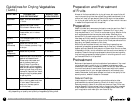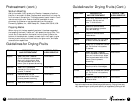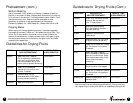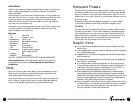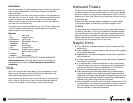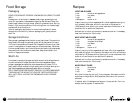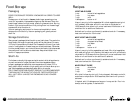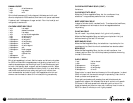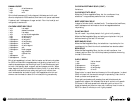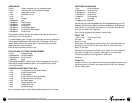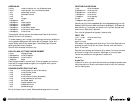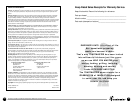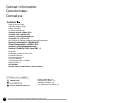
13.12.
Convection Toaster Oven-Broiler Dehydration Racks Use and Care Guide
Recipes
VEGETABLE PUREE
1 cup mixed dried vegetables
1
⁄
2
cup hot water
1
⁄
4
cup milk
1 tablespoon butter or oil
Use only very dry, brittle vegetables. Mix dried vegetables and grind
until powdery. Add water and milk, and allow to rehydrate for
15-25 seconds; then blend until puree is achieved. Add butter or oil
and blend for an additional 5 seconds.
Add salt and/or other condiment(s) as desired and stir. If necessary,
heat over low heat for 2-3 minutes.
MEAT-VEGETABLE PUREE
3
⁄
4
cup mixed dried vegetables
1
⁄
4
cup chopped dried meat
1
⁄
2
cup hot water
1
⁄
4
cup milk
1 tablespoon butter or oil
Use only very dry, brittle vegetables and meat. Mix dried vegetables
with meat and grind until powdery. Add water and milk, and allow to
rehydrate for 15-25 seconds; then blend until puree is achieved. Add
butter or oil and blend for an additional 5 seconds.
Add salt and/or other condiment(s) as desired and stir. If necessary,
heat over low heat for 2-3 minutes.
MIXED FRUIT PUREE
1 cup dried fruits
1
⁄
2
cup hot water
1
⁄
2
cup milk
Mix dried fruits and grind until finely chopped. Add water and milk,
and allow to rehydrate for 25-30 seconds; then blend until puree is
achieved.
If desired, add 1-2 tablespoons of sugar or honey and stir. Pour into
bowl(s) and refrigerate, if desired cold.
Food Storage
Packaging
DRIED FOODS MUST PROPERLY PACKAGED IN ORDER TO KEEP
WELL.
Package your dried foods in freezer plastic bags, squeezing out as
much air as possible. Heat-sealable bags may also be used. Store the
plastic bags inside of airtight metal, plastic or glass container. Storing
foods in rigid containers without first putting them into freezer bags
exposes the dried foods to air.
Vacuum packaging equipment for home use is available in some
stores around the country. Vacuum packaging will greatly extend
shelf life.
Storage Conditions
Store properly packaged dried foods in a cool, dark place. The cooler the
food is kept, the longer the optimal quality will be maintained. For every
18°F drop in temperature, the shelf life increases 2 to 3 times. If you have
room in a refrigerator or freezer, keep your dried foods there. Otherwise,
find the coolest place in your home to store dried foods. Light also causes
the quality and nutritive value to deteriorate. Keep dried foods in the
dark or in opaque containers.
Shelf Life
Fruits have a naturally high sugar and acid content, which allows them to
dry well and store for longer periods of time than vegetables. When
properly packaged and stored at room temperature or below (70°F or
less), most fruits will maintain a high quality and nutritional value up to a
year. Most vegetables are best when eaten within six months.
FRUITS AND VEGETABLES KEPT BEYOND THE RECOMMENDED
TIME MAY NOT BE AS NUTRITIOUS OR TASTE AS GOOD BUT
WILL NOT SPOIL UNLESS THE PACKAGING IS NO LONGER
INTACT.




